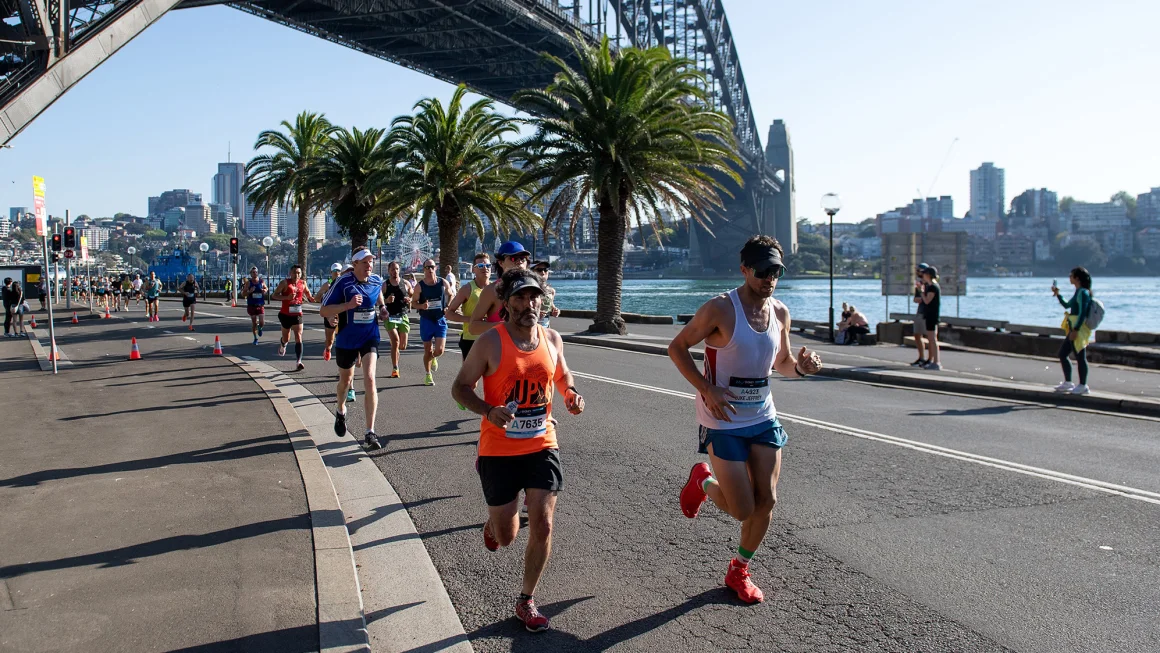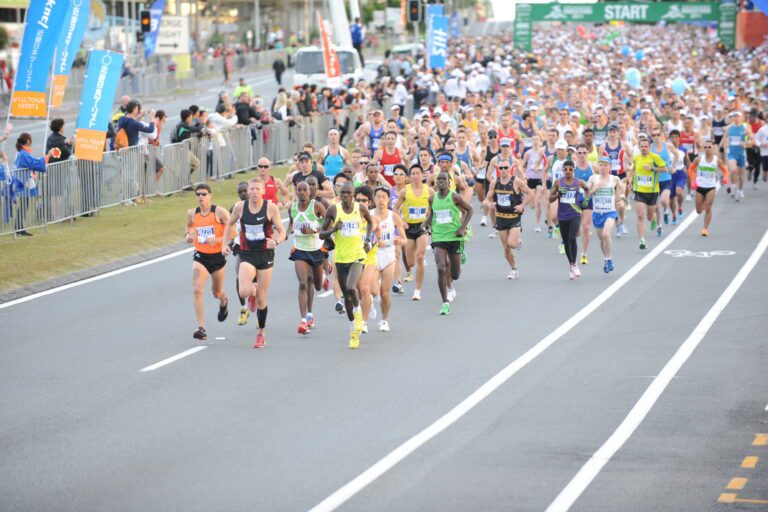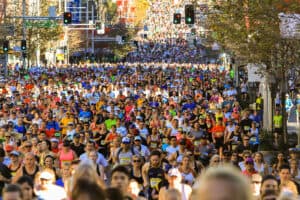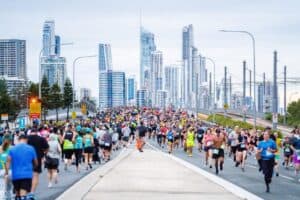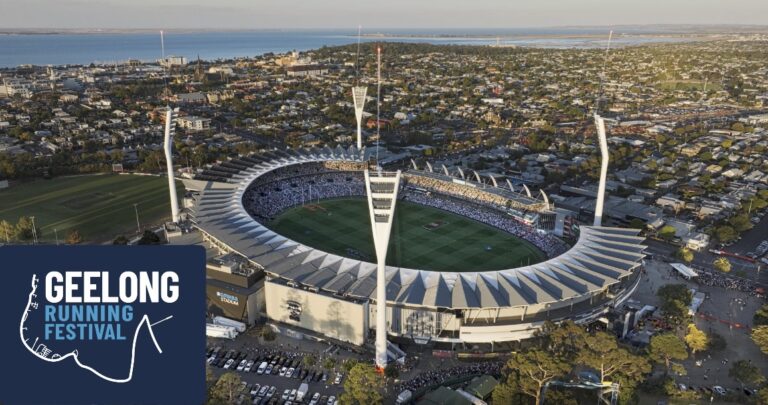Czech distance running legend Emil Zatopek famously said, “If you want to run, run a mile. If you want to experience a different life, run a marathon.” An increasing number of Australians are heeding those words in the post-COVID running boom, with 2025 set to be another record year for those tackling the iconic 42.195km distance.
In this article… (5 minute read)
Marathon evolution over past 50 years
Zatopek is widely recognised as one of history’s greatest distance runners, with his exploits in winning the 5000m, 10000m and marathon – on his first attempt at the distance – at the 1952 Helsinki Olympics unlikely to ever be repeated. But while the “Czech Locomotive” ran motivated by medals and records, for most the marathon is a personal contest against gravity itself, demanding endurance, willpower and determination to lift and push one’s body to the line over a journey of several hours.

In Australia, marathoning has come to embody this spirit of transformation. Post pandemic, the sport has seen a remarkable surge in popularity, becoming a more vibrant and integral part of the nation’s culture. Events like the Gold Coast Marathon, Melbourne Marathon, and particularly the Sydney Marathon have evolved into iconic celebrations that draw tens of thousands of runners from all walks of life.
The marathon was far from that in Zatopek’s times; in the year (1952) that he cemented his place in history, only 27 Australians completed a marathon. That number lifted to triple digits a decade later but only topped a thousand in 1978 when the inaugural Melbourne Marathon was held. A running boom in the 80s followed, peaking with over 14,000 marathoners in 1984, before declining and hovering in the 6,000-8,000 range from the late 80s to mid 2000s.
However, according to Ausrunning.net, last year over 50,000 runners finished a marathon in Australia.

Post pandemic boom
A boom in overall running participation during pandemic lockdowns – let’s face it, there wasn’t much else to do for physical activity – accelerated what had been an already increasing level of participation in running. But that doesn’t explain by itself all the reasons why more runners would attempt the distance that had previously been treated with reverence: to be attempted by more experienced runners having progressed through shorter races.
So what’s caused the increase? The reasons are as diverse as the runners themselves.
The marathon being presented as a more communal experience, along with an increase in the number of running communities through the rapid and organic creation of run clubs across the country, clearly has big a part to play.

So to does the attitudes of a new generation of runners who comprise them. For younger generations, particularly Gen Z, marathons represent not only a fitness challenge but also a path to self-discovery and transformation. The discipline required to train mirrors the resilience needed to navigate life’s uncertainties, making marathons a compelling goal for personal growth.
And while all big events have grown there’s no doubt that the Sydney Marathon’s successful push to become one of the World Marathon Majors, has been a huge part in the record numbers. From being the third largest marathon pre-pandemic at between two-thirds the size of the Melbourne Marathon and three-quarters the size of the Gold Coast Marathon, it has rapidly overtaken both and now dwarfs them, being larger than the two races combined.

Sydney Marathon leading the revolution
Australia’s leading running podcast, the Inside Running Podcast, recently interviewed the maestro behind the Sydney Marathon’s transformation, Wayne Larden.
“There was a real half marathon bucket list that traditional runners in Australia had… recalibrating the bucket list for regular runners in Australia was a key tactic for us.”
Wayne Larden, Sydney Marathon organiser
“The landscape changed a little bit after COVID… all the Aussie majors had really big field in the half marathon, you know, 12-14 thousand, I think we had 15 thousand one year.
“There was a real half marathon bucket list that traditional runners in Australia had, alongside something like the City2Surf,” he explained.
With a set of criteria to meet to join the World Marathon Majors including the need to dramatically increase the number of finishers in the marathon, Larden and his team embarked on a bold plan.
“Recalibrating the bucket list for regular runners in Australia was a key tactic for us.”

As a result, an unprecedented two out of every five runners that lined up in the Sydney Marathon last year were running their first marathon.
“The other thing that changed after COVID was all of these younger people, who traditionally would go to the gym to get their fitness and social outreach, started running. After COVID they wanted to do a race because they had been training for two years – they had no preconceptions,” Larden said.
Australia’s big three marathons (Sydney, Melbourne and the Gold Coast) make up about 60% of the overall finishing results each year, while around 1 in 6 runners finish more than one marathon. Which leads to the question: what are the other options available?
Best marathons to combine with Sydney and Melbourne
In 2025 August’s Sydney Marathon is already sold out – a ballot was needed for entries with the demand now that it is one of the World’s 7 Marathon Majors – while October’s Melbourne Marathon, constrained in its ability to grow as single day multi-race event, sold out within hours.
Gold Coast (5-6 July) is filling up quickly and is a feasible, but tight, option for those who wish to double up running Sydney or Melbourne, with 8 and 13 weeks respectively in between. More attractive is an autumn marathon in April, providing a longer break to recuperate, recharge and retrain. As a result these races are expected to boom this year:
Ballarat Marathon (26-27 April)
After a successful inaugural running last year the Ballarat Marathon is back bigger and better on over the weekend of 26-27 April. With course changes offering a total elevation for the event of only 98 metres and mild autumn weather the event offers a great opportunity for fast times.
Canberra Marathon (13 April)
Set against the backdrop of the nation’s capital, the Canberra Marathon is an iconic event that was once one of the most prominent marathons in the nation. The course takes runners past some of Australia’s most significant landmarks, including Parliament House and Lake Burley Griffin.
Hobart Marathon Festival (6 April)
The Hobart Marathon Festival is a celebration of Tasmania’s natural beauty and warm community spirit. Runners are treated to a course that hugs the Derwent River, offering breathtaking views of the waterfront and Mount Wellington. Known for its relaxed vibe and exceptional hospitality, this marathon is perfect for those seeking a scenic and rewarding autumn challenge.
Newcastle Marathon (19 April)
The Newcastle Marathon over Easter offers the challenge of the marathon distance over a four lap course.
If the marathon is for you there’s also plenty of other options around Australia to experience a different a different life.
